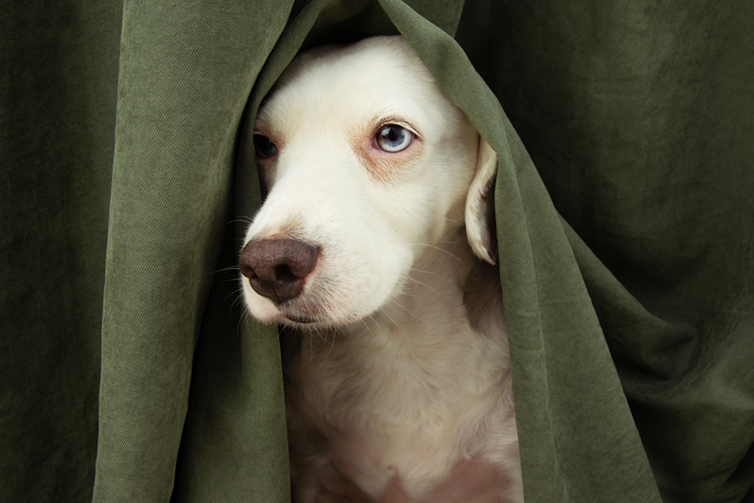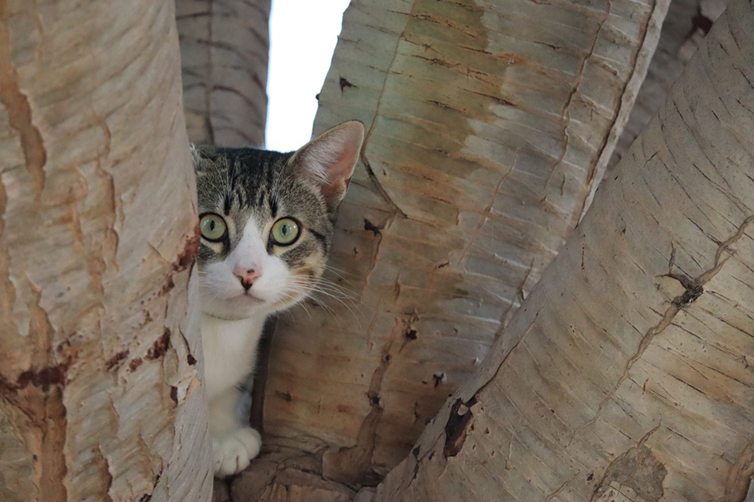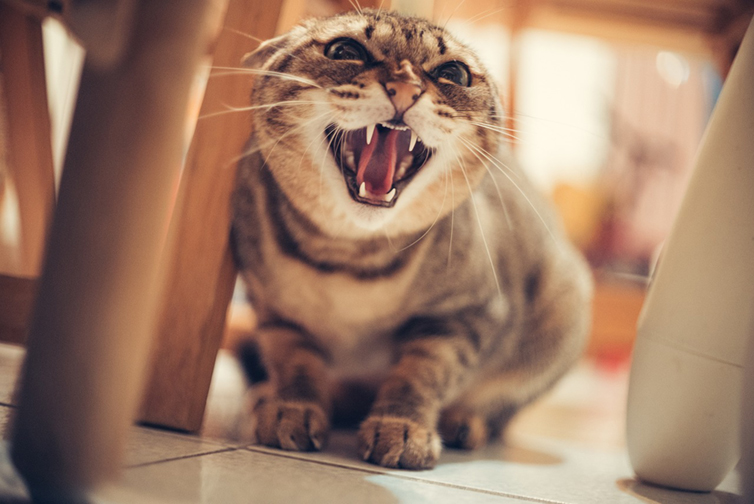Anxious Furry Friends
We live in an increasingly stressful world. Feeling anxious and even afraid can be a normal and even essential way to react to stressful situations. When our ancestors lived in caves and came upon a man-eating lion, their bodies would have immediately reacted: adrenaline would have been released and they would have gone into, what the scientists call, ‘fight or flight’ mode. They would then have chosen whether to stand and fight or to run away.

This instinct still remains today, in humans and in animals. It was essential for the cave-people, but is not so essential now. There aren’t too many man-eating lions roaming our streets. But there are certainly stressful situations, for us and for our pets. The situations may be different but the physiological reactions are similar. In a stressful situation, the adrenaline released, in turn, releases the hormone, cortisol. Too much of these hormones can be harmful to our bodies and our minds. The same applies to our pets. Clearly, it is important to try to control our stress levels, and those of our furry friends.
The longer that anxiety and stress-related conditions are untreated, the more difficult they are to treat. Besides, no pet parent wants to witness a distressed animal suffering from fear and anxiety, especially if this is long-term.
We are going to look at the problem of anxiety in both dogs and cats. Where the information differs, we shall discuss dogs and cats separately.
Let’s try to answer some of your questions on this subject.
What’s the difference between anxiety, fears and phobias?

Fear is an alarm-reaction to a real danger which actually exists (e.g. fire, an aggressive dog/cat, a threatening human etc).
Anxiety is a reaction to a situation which is perceived by the animal as threatening or dangerous. It usually refers to ‘future’ possible dangers (e.g. anxiety on the way to the vet).
Phobias are when the reaction to the perceived threat or is out of proportion to the actual danger (e.g. fear reaction to the sound of thunder which cannot harm the pet). Phobic reactions are usually the most severe of stress-related behaviours.
What are some common sources of fear, anxiety and phobias in pets?

These are also known as stressors.
- Loud noises, such as thunder and fireworks. This usually applies only to dogs, but there are cats who are afraid of fireworks and thunder.
- Unfamiliar animals or people
- Vets
- Car journeys (especially to the vet. How on earth do they know?)
- Separation anxiety (which usually only applies to dogs but some cats experience this as well).
- Wide, open spaces (usually only applies to cats).
How do I know if my dog or cat is stressed?
There are many behaviours which may indicate that your pet is highly stressed:
- Raised hackles
- Aggression
- Destructive behaviour
- Tightened lips
- High alertness
- Tense muscles
- Dilated pupils
- Panting
- Flattened ears
- Over or under activity
- Tail lowered and possibly slightly wagging
- Over-grooming
- Drooling
- Vocal noises
- Sniffing
- Excess urinating/defaecating
- Biting/baring of teeth
Of course, most of these behaviours may be explained by reasons other than stress: the overall situation, or context, should be taken into account.
Is there any way I can prevent my pets from becoming anxious and stressed?
Let’s look at dogs first.
Socialisation
Introducing your dog – preferably as a puppy – to other dogs, new people, new experiences and places, can help him/her to realise that there is no threat and therefore he/she should not develop exaggerated and distressing fear responses. Puppy socialization classes are a good way of helping your doggie to mix and play with other little canines. Look online to find classes in your area.
Obedience Training
This is linked to socialization. A dog who is well-trained and learns acceptable behaviours, is less likely to become anxious and stressed and is easier to train if he/she develops undue anxiety.
Reading Body Language
If you know your dog well enough, you can begin to recognize when he/she is feeling nervous or uncomfortable about a situation BEFORE serious anxiety kicks-in. Obviously, all possible stressors cannot be avoided, but you can take steps to calm and reassure your pooch and possibly use the experience as a training example.
Nutrition, Exercise and Stimulation
Making sure that you take care of your pooch’s physical and psychological needs can help to prevent the development of serious anxiety problems. A well-balanced, good-quality diet and regular exercise are important for a healthy body and mind. Mental stimulation, possibly in the form of walks or playtime, prevents boredom which may result in destructive behaviour, which in itself is a symptom of anxiety.
And now, kitties.
Socialisation
As with their canine friends (enemies?), your cat needs to be exposed to a variety of social situations in a positive way, preferably before they are 7 weeks old, but research has shown that socialization can benefit kitties up to 14 weeks old. This does not mean forcing kittie to put up with stressful situations, such as lots of strange people at once when he/she has only been used to you. Try one new person at a time – preferably a cat lover of course.
Reading Body Language
You will begin to recognize when your little ball of fluff is getting anxious or upset. Perhaps remove him/her from the stressor for a time, especially when still a kitten, and if possible, gradually reintroduce kittie to the stressful situation at a future date. Always keep calm and be encouraging.
Nutrition, Exercise and Stimulation
A good-quality, well-balanced diet is essential for kitty’s physical and psychological well-being. Stimulation and exercise are also important for healthy bodies and brains. If your cat is confined to a flat or a house, you need to make a plan to provide opportunities for exercise. In a flat, a tree branch can provide vital climbing and scratching practise, while an enclosure encased in chicken-wire in the garden will make kitty very happy if he/she is confined to a house.
How can my pet’s anxiety, fear and phobias be treated?
Your vet will be able to help you to deal with your pet’s anxiety. She will help to identify the type, causes and triggers. She will also be able to rule out any physical problems which may be involved, and then advise you on treatment options, which will usually involve a combination of training and possibly medication.
And now, in spite of the fact that they are both furry, we all know that cats and dogs are very different, particularly in terms of their behaviour. So we are going to discuss dogs first.
Treatment Options for Anxious Pooches
Training
Your vet may advise you to contact a professional animal behaviourist, because training an anxious, stressed canine is not easy and you will need to learn some techniques.
- Counter-Conditioning
This process is intended to change your pooch’s response when faced with a stressful situation. The anxious behaviour is replaced by a more acceptable response, for example keeping calm, sitting or lying. The trainer achieves this change by rewarding your doggie (usually with small treats and praise) when he/she shows signs of performing the desirable behaviour, and by ignoring anxious responses. No form of punishment is used as it has been proven to be ineffective when a change in behaviour is required. Shouting and smacking will only make the doggie more anxious and he/she will learn nothing.
- Desensitisation
The trainer will show you how to slowly introduce your poochie to the stressful situation. For example, starting with a slight noise, rewarding your dog when he/she stays calm and gradually increasing the noise level, praising and rewarding at each small stage. This is a slow process so don’t expect great improvements in a few training sessions.
Medication
If your poochie develops a serious anxiety disorder, your vet may prescribe medication, which may be chemical or natural.
For certain situations which have caused stress in the past, for example, long car journeys, fireworks, thunderstorms, your vet may prescribe a tranquilising drug such as benzodiazepine, which will help your pooch to cope with such situations temporarily. Special anti-depressants made for dogs may also be an option, but these take several weeks to ‘kick-in’ and are therefore not useful as a ‘once-off’ treatment.
Natural products are also available to help relieve your anxious doggie. These usually contain pheromones or aromotherapeutic ingredients which may help your dog to cope better in stressful situations.
You should always consult your vet before giving your doggie any medication, whether chemical or natural.
Treatment Options for Anxious Kitties

Training
Yes, it is possible to train your kitty with time and patience. Your vet will be able to recommend an animal behaviourist who can use counter-conditioning or desensitization.
In counter- conditioning, you and the trainer will identify the stressors which are making kitty anxious and the trainer will then introduce the stressor and reward him/her (with praise and/or a treat) for being calm and relaxed and will ignore any stressful responses. No punishment is ever administered.
The trainer may attempt to desensitize him/her to these stressors by exposing kittie to them, very slowly, in gradual steps, using positive reinforcement (rewarding ‘good’ behaviour and ignoring ‘bad’ behaviour i.e. a ‘fear’ response) so that kitty learns that the stressor is not harmful.
Medication
Your vet may prescribe medication if your kitty’s anxiety is serious. Anti-anxiety medications usually work within an hour or two and are obviously useful for upcoming events such as fireworks, a long car journey or when a bad thunderstorm is predicted. Anti-depressants take several weeks to work. They affect the chemicals in your cat’s brain and can assist in reducing stress. Cats are usually kept on these anti-depressants for some months and must be weaned off them, on the advice of your vet, gradually.
Never give any medication to your cat without consulting your vet first.
How do I help my pets who are terrified of thunderstorms and fireworks?

Our pets have ultra-sensitive ears and loud noises, which may not bother us, may actually be painful for them, causing, in some cases, extreme stress and anxiety. They may even seriously injure themselves in an attempt to ‘get away’ from the noise (ask any vet the day after November 5th or other holidays).
Dogs
If possible, try to create a ‘positive response’ in dogs who have not developed extreme fear of these loud noises, by making the event as calm, relaxing and pleasurable as possible for your animals. Sit with them in a small room and talk to them, give them treats, play games and play quiet music.
If your pet has already developed severe anxiety responses around storms and fireworks, try to minimize their fearful experience by again putting them in a small room, playing music or turning on a fan to mask outside noise. Treats and games will also help.
But there are, sadly, those dogs whose reactions to such stressors are extreme. Ensure that they are never alone and that you remain calm. Sitting close to the animal and hugging them can help, even sitting with them in a confined space such as a wardrobe. If you absolutely cannot be at home, try to get a sitter who knows your pet – and who doesn’t mind crouching in a wardrobe!
Your vet may be able to prescribe calming medication, but this does not always work when the animal is highly agitated. Some vets will take such pets into their hospitals for the night which at least restricts their movements and reduces the chances of injury.
There are other options on the market, such as anxiety shirts, wraps or jackets, which, in theory, apply gentle pressure to the animal’s body, thus calming them down.
Cats
Cats are not always as terrified of loud noises as dogs, but some can be. They tend to attempt to hide from it.
Keep your cats inside by ensuring all doors and windows are closed.
Make sure your cat has a safe and secure place in which to hide, which may simply be under a bed, and do not attempt to pull or persuade kitty to come out. She/he has chosen that place because they feel protected and safe and the frightening noises are muffled.
If kitty has not found a place, provide him/her with one: possibly a crate or box in a secure room. Bring in some favourite toys and blankets and put on the T.V. or radio to drown out some of the noise. Ensure they have food. Water and a litter box.
If kitty has had an extreme reaction in the past, consult your vet who may prescribe calming medication.
Anxiety wraps and jackets are available which, in theory, calm the cat down.
And finally …
We hope that we have answered all your questions and that you will find the information helpful. A seriously anxious pet is not easy to deal with, but remember that your vet is the first port-of-call.
ZA-NON-230100002
Subscribe to our Newsletter
Get to know your furry friend better! Sign up for all things dog- or cat-related.
The Hairy Facts about the dreaded hairball
12 April 2021
Help! My dog’s barking mad! Volume 2
12 April 2021
Your Itchy, Scratchy Cat – All About Cat Skin Problems
12 April 2021
The Dog’s Diet: A Bone of contention?
01 April 2021
Mango Fly Worms: How to Spot and Eliminate them
Posted on November 28,2019
Managing Mange And Mites In Your Dog
Posted on June 11,2018
Why Do Cats Purr and How? Learn What Your Cat Is Saying
Posted on October 14,2020
How to Get Rid of Ear Mites in Dogs
Posted on November 06,2019









